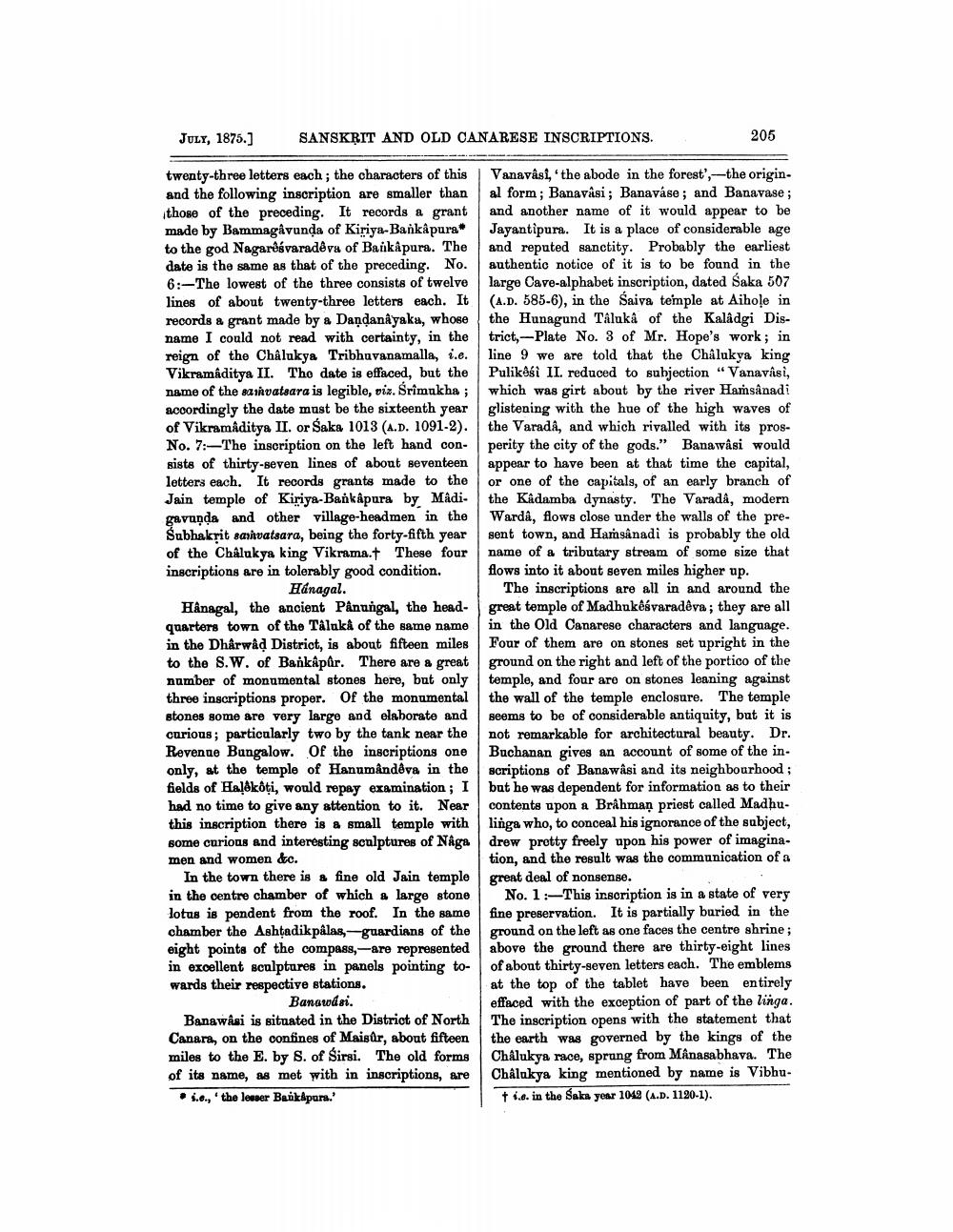________________
JULY, 1875.]
SANSKRIT AND OLD CANARESE INSCRIPTIONS.
205
twenty-three letters each; the characters of this and the following inscription are smaller than those of the preceding. It records a grant made by Bammagávunda of Kiriya-Bankapura* to the god Nagarðsvaradeva of Baikapura. The date is the same as that of the preceding. No. 6:-The lowest of the three consists of twelve lines of about twenty-three letters each. It records a grant made by a Dandanayaka, whose name I could not read with certainty, in the reign of the Chalukya Tribhuvanamalla, i.e. Vikramaditya II. The date is effaced, but the name of the samvatsara is legible, viz. Srimukha ; accordingly the date must be the sixteenth year of Vikramaditya II. or Saka 1013 (A.D. 1091-2). No. 7:—The inscription on the left hand con- sists of thirty-seven lines of about seventeen letters each. It records grants made to the Jain temple of Kiriya-Bankapura by Mâdi. gavanda and other village-headmen in the Subhakrit saivatsara, being the forty-fifth year of the Chalukya king Vikrama.t These four inscriptions are in tolerably good condition.
Hánagal. Hânagal, the ancient Pânungal, the head- quarters town of the Talaka of the same name in the Dharwad District, is about fifteen miles to the S.W. of Bankapûr. There are a great number of monumental stones here, but only three inscriptions proper. Of the monumental stones some are very large and elaborate and curious; particularly two by the tank near the Revenge Bungalow. Of the inscriptions one only, at the temple of Hanumândêva in the fields of Halékoti, would repay examination; I had no time to give any attention to it. Near this inscription there is a small temple with some curious and interesting sculptures of Någa men and women &c.
In the town there is a fine old Jain temple in the centre chamber of which a large stone lotus is pendent from the roof. In the same chamber the Ashtadik pålas,-guardians of the eight points of the compass,--are represented in excellent sculptures in panels pointing towards their respective stations.
Banaudai. Banawaai is situated in the District of North Canara, on the confines of Maigur, about fifteen miles to the E. by S. of Sirsi. The old forms of its name, as met with in inscriptions, are
• s.c.,' the lesser Barkápura.'
Vanavasi, the abode in the forest',--the origin. al form; Banavasi; Banavase; and Banavase; and another name of it would appear to be Jayantipura. It is a place of considerable age and reputed sanctity. Probably the earliest authentic notice of it is to be found in the large Cave-alphabet inscription, dated Saka 507 (A.D. 585-6), in the Saiva temple at Aihole in the Hunagund Taluka of the Kalâdgi District,-Plate No. 3 of Mr. Hope's work; in line 9 we are told that the Chalukya king Pulikasi II. reduced to subjection "Vanavasi, which was girt about by the river Hamsånadi glistening with the hue of the high waves of the Varada, and which rivalled with its prosperity the city of the gods." Banawasi would appear to have been at that time the capital, or one of the capitals, of an early branch of the Kadamba dynasty. The Varada, modern Warda, flows close under the walls of the present town, and Hamsanadi is probably the old name of a tributary stream of some size that flows into it about seven miles higher up.
The inscriptions are all in and around the great temple of Madhukêśvaradêva; they are all in the Old Canarese characters and language. Four of them are on stones set upright in the ground on the right and left of the portico of the temple, and four are on stones leaning against the wall of the temple enclosure. The temple seems to be of considerable antiquity, but it is not remarkable for architectural beauty. Dr. Buchanan gives an account of some of the inscriptions of Banawasi and its neighbourhood; but he was dependent for information as to their contents upon a Brâhman priest called Madhulinga who, to conceal his ignorance of the subject, drew pretty freely upon his power of imagina. tion, and the result was the communication of a great deal of nonsense.
No. 1:- This inscription is in a state of very fine preservation. It is partially buried in the ground on the left as one faces the centre shrine; above the ground there are thirty-eight lines of about thirty-seven letters each. The emblems at the top of the tablet have been entirely effaced with the exception of part of the linga. The inscription opens with the statement that the earth was governed by the kings of the ChAlukya race, sprang from MÂnasabhava. The Chalukya king mentioned by name is Vibhu
+ .c. in the Saka year 1049 (A.D. 1120-1).




